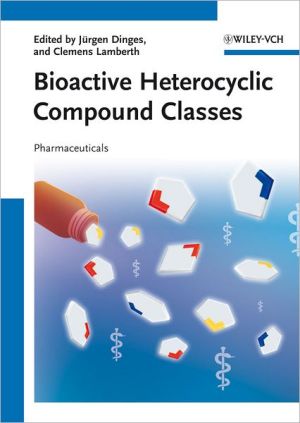

 |

|

Sold Out
Book Categories |
Preface XI
List of Contributors XIII
Introduction 1
1 The Significance of Heterocycles for Pharmaceuticals and Agrochemicals 3
Clemens Lamberth and Jürgen Dinges
1.1 Introduction 3
1.2 Heterocycles as Framework of Biologically Active Compounds 4
1.3 Fine-Tuning the Physicochemical Properties with Heterocycles 6
1.4 Heterocycles as Prodrugs 6
1.5 Heterocycles as Peptidomimetics 7
1.6 Heterocycles as Isosteric Replacement of Functional Groups 8
1.7 Heterocycles as Isosteric Replacement of Alicyclic Rings 11
1.8 Heterocycles as Isosteric Replacement of other Heterocyclic Rings 13
References 16
Part I Neurological Disorders 21
2 Tropane-Based Alkaloids as Muscarinic Antagonists for the Treatment of Asthma, Obstructive Pulmonary Disease, and Motion Sickness 23
Michael L. Schulte and Craig W. Lindsley
2.1 Introduction 23
2.2 History 23
2.3 Synthesis 25
2.4 Mode of Action 29
2.5 Structure–Activity Relationships 32
References 34
3 Morphinone-Based Opioid Receptor Agonist Analgesics 37
Stephanie M. Ng
3.1 Introduction 37
3.2 History 37
3.3 Synthesis 40
3.4 Mode of Action 43
3.5 Structure–Activity Relationship 44
References 48
4 Barbituric Acid-Based GABA(A) Receptor Modulators for the Treatment of Sleep Disorder and Epilepsy and as Anesthetics 51
Ingo Janser and Romy Janser
4.1 Introduction 51
4.2 History 52
4.3 Synthesis 57
4.4 Mode of Action 60
4.5 Structure–Activity Relationship 62
References 63
5 Phenothiazine-Based Dopamine D2 Antagonists for the Treatment of Schizophrenia 65
Cristiana A. Zaharia
5.1 Introduction 65
5.2 History 65
5.3 Synthesis 70
5.4 Mode of Action 72
5.5 Structure–Activity Relationships 76
References 77
6 Arylpiperazine-Based 5-HT1A Receptor Partial Agonists and 5-HT2A Antagonists for the Treatment of Autism, Depression, Anxiety, Psychosis, and Schizophrenia 81
Irini Akritopoulou-Zanze
6.1 Introduction 81
6.2 History 81
6.3 Synthesis 85
6.4 Mode of Action 88
6.5 Structure–Activity Relationship 89
References 96
7 Arylpiperidine-Based Dopamine D2 Antagonists/5-HT2A Antagonists for the Treatment of Autism, Depression, Schizophrenia, and Bipolar Disorder 99
Ying Wang
7.1 Introduction 99
7.2 History 99
7.3 Synthesis 106
7.4 Mode of Action 109
7.5 Structure–Activity Relationship 111
References 113
8 Dibenzazepine-Based Sodium Channel Blockers for the Treatment of Neuropathic Pain 115
Derek W. Nelson
8.1 Introduction 115
8.2 History 115
8.3 Synthesis 119
8.4 Mode of Action 124
8.5 Structure–Activity Relationships 128
References 130
Part II Cardiovascular Diseases 135
9 Dihydropyridine-Based Calcium Channel Blockers for the Treatment of Angina Pectoris and Hypertension 137
Milan Bruncko
9.1 Introduction 137
9.2 History 139
9.3 Synthesis 141
9.4 Mode of Action 144
9.5 Structure–Activity Relationship 148
References 149
10 Tetrazole-Based Angiotensin II Type 1 (AT1) Antagonists for the Treatment of Heart Failure and Congestive Hypertension 153
Edward C. Lawson, Brian C. Shook, and James C. Lanter
10.1 Introduction 153
10.2 History 154
10.3 Synthesis 157
10.4 Mode of Action 159
10.5 Structure–Activity Relationship 161
References 163
11 Thiazide-Based Diuretics for the Treatment of Hypertension and Genitourinary Disorders 169
Jürgen Dinges
11.1 Introduction 169
11.2 History 169
11.3 Synthesis 174
11.4 Mode of Action 177
11.5 Structure–Activity Relationship 179
References 180
12 Tetrahydropyranone-Based HMG-CoA Reductase Inhibitors for the Treatment of Arterial Hypercholesterolemia 183
Hongyu Zhao
12.1 Introduction 183
12.2 History 183
12.3 Synthesis 188
12.4 Mode of Action 191
12.5 Structure–Activity Relationship 192
References 198
Part III Infectious Diseases 201
13 Adenine-Based Reverse Transcriptase Inhibitors as Anti-HIV Agents 203
Alastair Donald
13.1 Introduction 203
13.2 History 203
13.3 Synthesis 209
13.4 Mode of Action 212
13.5 Structure–Activity Relationship 212
References 214
14 Guanine-Based Nucleoside Analogs as Antiviral Agents 217
Maurizio Franzini
14.1 Introduction 217
14.2 History 219
14.3 Synthesis 221
14.4 Mode of Action 227
14.5 Structure–Activity Relationship 229
References 232
15 Penicillin and Cephalosporin Antibiotics 237
Michael Z. Hoemann
15.1 Introduction 237
15.2 History 237
15.3 Synthesis 239
15.4 Mode of Action 248
15.5 Structure–Activity Relationships 250
References 251
Part IV Oncology 255
16 Pyrimidine-Based Kinase Inhibitors in Cancer Chemotherapy 257
Robert Mah
16.1 Introduction 257
16.2 History 257
16.3 Synthesis 261
16.4 Mode of Action 264
16.5 Structure–Activity Relationship 266
References 269
17 Benzyl Triazole-Based Aromatase Inhibitors for the Treatment of Breast Cancer 275
Dawn George and Stacy Van Epps
17.1 Introduction 275
17.2 History 275
17.3 Synthesis 277
17.4 Mode of Action 281
17.5 Structure–Activity Relationship 282
References 286
Part V Inflammation and Gastrointestinal Diseases 289
18 Acetonide-Based Glucocorticoids for the Treatment of Asthma, Skin Inflammation, and Diseases of the Eye 291
Kevin P. Cusack, Vikram G. Kalthod, Rajarathnam E. Reddy, and Sanjay R. Chemburkar
18.1 Introduction 291
18.2 History 293
18.3 Synthesis 297
18.4 Mode of Action 304
18.5 Structure–Activity Relationship 308
References 311
19 Benzimidazole-Based H+/K+-ATPase Inhibitors for the Treatment of Gastroesophageal Reflux Disease 313
Steve Swann
19.1 Introduction 313
19.2 History 313
19.3 Synthesis 316
19.4 Mode of Action 319
19.5 Structure–Activity Relationships 320
References 324
Part VI Metabolic Diseases 327
20 Thiazolidinedione-Based Insulin Sensitizers: PPAR-γ Agonists for the Treatment of Type 2 Diabetes 329
Steven Richards
20.1 Introduction 329
20.2 History 329
20.3 Synthesis 337
20.4 Mode of Action 343
20.5 Structure–Activity Relationship 344
References 345
Index 349
Login|Complaints|Blog|Games|Digital Media|Souls|Obituary|Contact Us|FAQ
CAN'T FIND WHAT YOU'RE LOOKING FOR? CLICK HERE!!! X
 You must be logged in to add to WishlistX
 This item is in your Wish ListX
 This item is in your CollectionBioactive Heterocyclic Compound Classes: Pharmaceuticals
X
 This Item is in Your InventoryBioactive Heterocyclic Compound Classes: Pharmaceuticals
X
 You must be logged in to review the productsX
 X
 X

Add Bioactive Heterocyclic Compound Classes: Pharmaceuticals, The chemistry of heterocycles is an important branch of organic chemistry. This is due to the fact that a large number of natural products, e. g. hormones, antibiotics, vitamins, etc. are composed of heterocyclic structures. Often, these compounds sho, Bioactive Heterocyclic Compound Classes: Pharmaceuticals to the inventory that you are selling on WonderClubX
 X

Add Bioactive Heterocyclic Compound Classes: Pharmaceuticals, The chemistry of heterocycles is an important branch of organic chemistry. This is due to the fact that a large number of natural products, e. g. hormones, antibiotics, vitamins, etc. are composed of heterocyclic structures. Often, these compounds sho, Bioactive Heterocyclic Compound Classes: Pharmaceuticals to your collection on WonderClub |